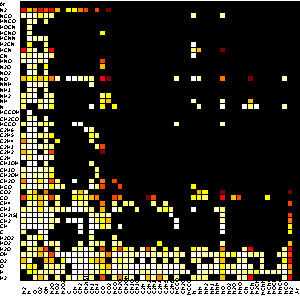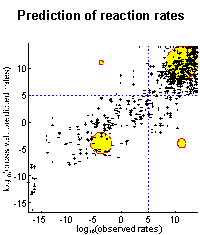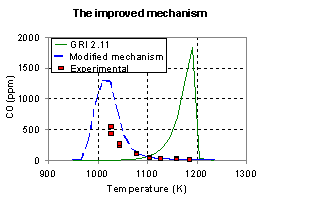Identification of
Missing Reactions in Detailed Reaction Mechanisms
|
Poster presented at 27th International Symposium on Combustion, Boulder, CO,
USA, Aug. 3-7th 1998
The information
structure of a reaction mechanism consist of three parts: 
- The species participating in reactions
- The reactions occurring between species
- The rates of reactions
Most of the
focus in the construction of detailed chemical reaction mechanisms is put on
the accurate measurement or estimation of reaction rate constants. However, one
important fact which is often overlooked is that the
absence of a reaction is equal to estimating the rate to be zero!
A reaction grid may be
designed to ensure exploration of all combinations of reactants and products
from a predefined set of species. A reaction grid based on the reaction rates
used in GRI Mech. 2.11 is presented graphically. In this figure the color
intensity symbolizes the reaction rate of reactions between two species as
1000K, e.g. white correspond to a reaction rate of 1015, while black correspond
to a reaction rate of zero. The objective of this work was to investigate
whether any of the reactions left out should have reaction rates different from
zero. This is done by constructing an empirical QSAR model for estimation of
reaction rates from their gross structure.
The concept for estimation of reaction rates2
The objective of our method for estimation of reactions was to
- estimate reaction rates for
reactions between as wide a range of species as possible
- with a minimal computational effort
(as many estimates are to be calculated)
- with an accuracy sufficient for
determining whether the reaction should be investigated in detail or not.
The
reaction rates are related to the electronic structure of reactants and
products. This structure was described as the number of bond types, the number
of unpaired electrons and the number of lone-pairs, as it is exemplified in the
table for O/H species. For O/H/C/N species the total number of characteristics
was 27.
A reaction was described by a vector consisting of the characteristics of
reactants and products, and a vector b of coefficients in a linear regression
model may be calculated from the reactions in an existing mechanism using
Partial Least Squares (PLS). This model can be used for prediction of reaction
rates not included in the reaction mechanism.

|
Case
Study Results3 |
|
|
|
|
|
|
Conclusion
A method for expansion of reaction mechanisms was suggested, and demonstrated
in a case study. An improved estimation quality of the PLS model is desired,
and the some suggestions for obtaining this may be an estimation of reaction
rates in the exothermal direction as well as a better characterization of the
reacting species, e.g. through graph theoretical descriptors. The estimation
task may also be simplified by removing reactions with radicals, since other
methods exist for such estimations.
References
1) Frenklach M. et al (1996) http://www.me.berkeley.edu/gri_mech/
2) Bendtsen A.B., & P. Glarborg. (1998) Fashioning a Model: Optimization
Methods in Chemical Physics pp. 55-60
3) Bendtsen A.B., P. Glarborg, & K. Dam-Johansen (1998). Chemom.Intell.Lab.Syst.
44, 357‑365
4) Bromly J.H., F.J. Barnes, S. Muris, X. You, & B.S. Haynes. Comb.Sci.Tech.
115, (1996), 259-296
Acknowledgments
This work was supported by the Danish Ministry of Energy, the Danish Gas
Technology Centre and the CHEC Research Programme. The Danish Gas
Technology Centre is sponsored by the national and regional Danish gas
companies. The CHEC (Combustion and Harmful Emission Control) Research
Programme is cofunded by a.o. the Danish Technical Research Council and the
Danish energy consortia Elsam and Elkraft.
![]() to Anders Broe Bendtsen's home page
to Anders Broe Bendtsen's home page
Last
updated: February18th 2001


